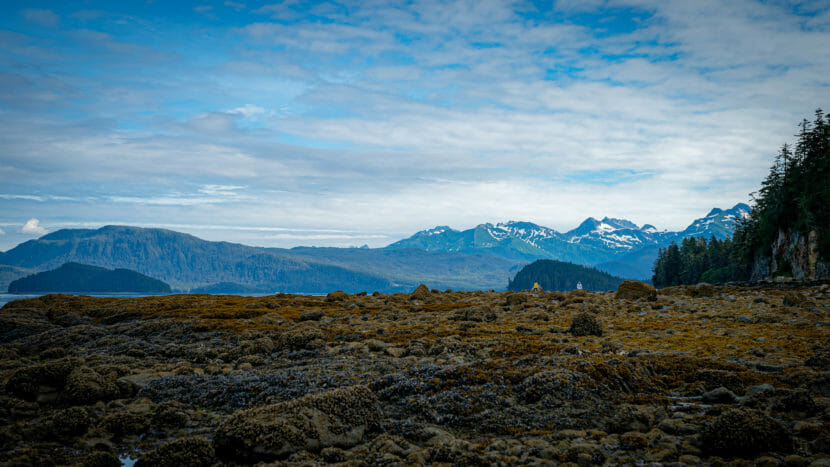
Most of the birders who pulled into Juneau’s Rainforest Trail parking lot at 8 a.m. on Friday were locals, but docent Brenda Wright set some expectations for out-of-towners and newbies.
“This is a really hot spot for red-breasted sapsucker,” she said.
“You’re kidding — that’s why I’m here!” said tour-goer Lynn Hartmann.
She and her partner, Martha Johnson, are visiting Juneau from Minnesota. Hartmann came for the birds: red-breasted sapsuckers, red-throated loons, Pacific wrens and the Pacific-slope flycatcher. She’s among the growing number of tourists who come to Alaska each year to look for birds.
A recent study out of the University of Alaska Fairbanks shows that birders like them could be a boon for the economy and for conservation efforts — especially in rural and remote areas.
Birders stay longer and spend more
The couple is in town for a week, staying at a bed and breakfast. They’ve been to the Mendenhall Glacier to see Arctic terns, took a whale-watching tour for more seabirds, and now they’re on a guided walk through the temperate coastal rainforest with the Audubon Society.

But they’re doing other things, too. Johnson goes to the municipal pool every morning, and she says they’ve been sampling the local restaurants.
“We’ve been trying to take advantage of local culture — you know, we can’t bird 12 hours a day! So it’s been sort of a multifaceted trip,” Johnson said.
Birders are the world’s largest group of eco-tourists. And according to the new study, they’re a real moneymaker in Alaska — and the state has only begun to cash in.
“Birders, compared to non-birders, stay twice as long, and they’re considerably spending more money than the average, or non-birding, visitor to Alaska,” said Tobias Schwoerer, one of the study’s authors and a research professor at UAF’s International Arctic Research Center.
“All the people who said they watched birds, if we sum up their spending, it was over $300 million dollars in 2016,” Schwoerer said.
The more than 300,000 birders a year that visit Alaska generate more than 3,000 jobs in the state, according to the study. Schwoerer likened the jobs figure to the total number of Alaskans employed by other single industries, like telecommunications.
An intact ecosystem
They’re coming because Alaska is home to the world’s largest concentration of shore birds, and it’s a globally significant breeding ground for migratory birds. Alaska has the most Important Bird Areas of any state — and yes, Important Bird Area is an international metric, overseen in the United States by the Audubon Society.
“We have these hotspots, and they’re still intact,” Schwoerer said. “Alaska is kind of the last little bit of wild where they can have a very intact ecosystem to support their populations.”
He says that climate change is increasingly threatening wilderness and biodiversity, but Alaska can capitalize on wildlife tourism through conservation and infrastructure. That means opportunity statewide, but especially in rural places.

Natalie Dawson, another of the study’s authors, says she got the idea for it while guiding in remote parts of Alaska.
“If I was in a community and there was a rare bird that had blown over from some other place in the circumpolar north, I would find people that had traveled thousands of miles just to see individual birds,” she said.
She said birders are motivated to get out where the birds are — places like the North Slope to see eider ducks or out west to the Pribilof Islands for seabirds.
Southeast festivals are a big draw
But Dawson says the study showed that more than half of the birders’ money is spent in Southeast Alaska. She credits that in part to bird festivals like the Hummingbird Festival in Ketchikan and the Bald Eagle Festival in Haines.
“Those festivals do seem to actually, yes, be congregations for birding, tourism and birding related travelers,” Dawson said. “This study shows that if you can come together with a vision for a community and an activity that can draw people in and provide them information about how to experience that wildlife, then it does seem to draw people to your area.”

Cordova’s Copper River Delta Shorebird Festival has lured birders off the road system for decades. The local chamber of commerce estimates that more than 100 visitors this year spent nearly $175,000 in town, jump-starting the local businesses reopening after a quiet winter.
Back on the Rainforest Trail in Juneau, Lynn Hartmann stood in the trees, listening. Varied thrushes were whistling their haunting notes over the melodic song of the Swainson’s thrush.
“It’s like, hearing 20 languages all at once,” Hartmann said.
There was no red-breasted sapsucker, but she and Martha spotted a Pacific slope flycatcher and heard his signature song. And there was still time for the sapsucker — they were in town for a few more days.



